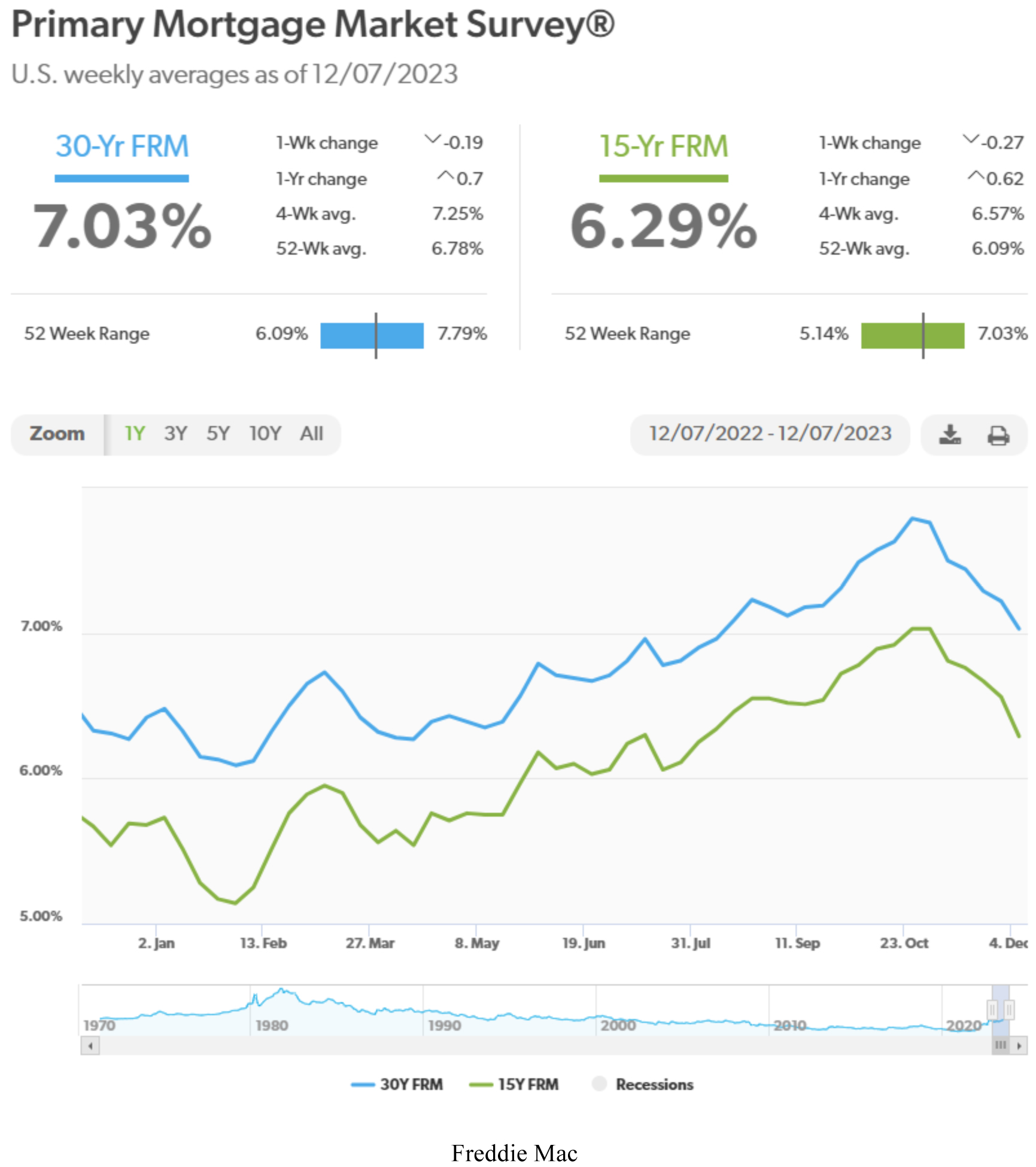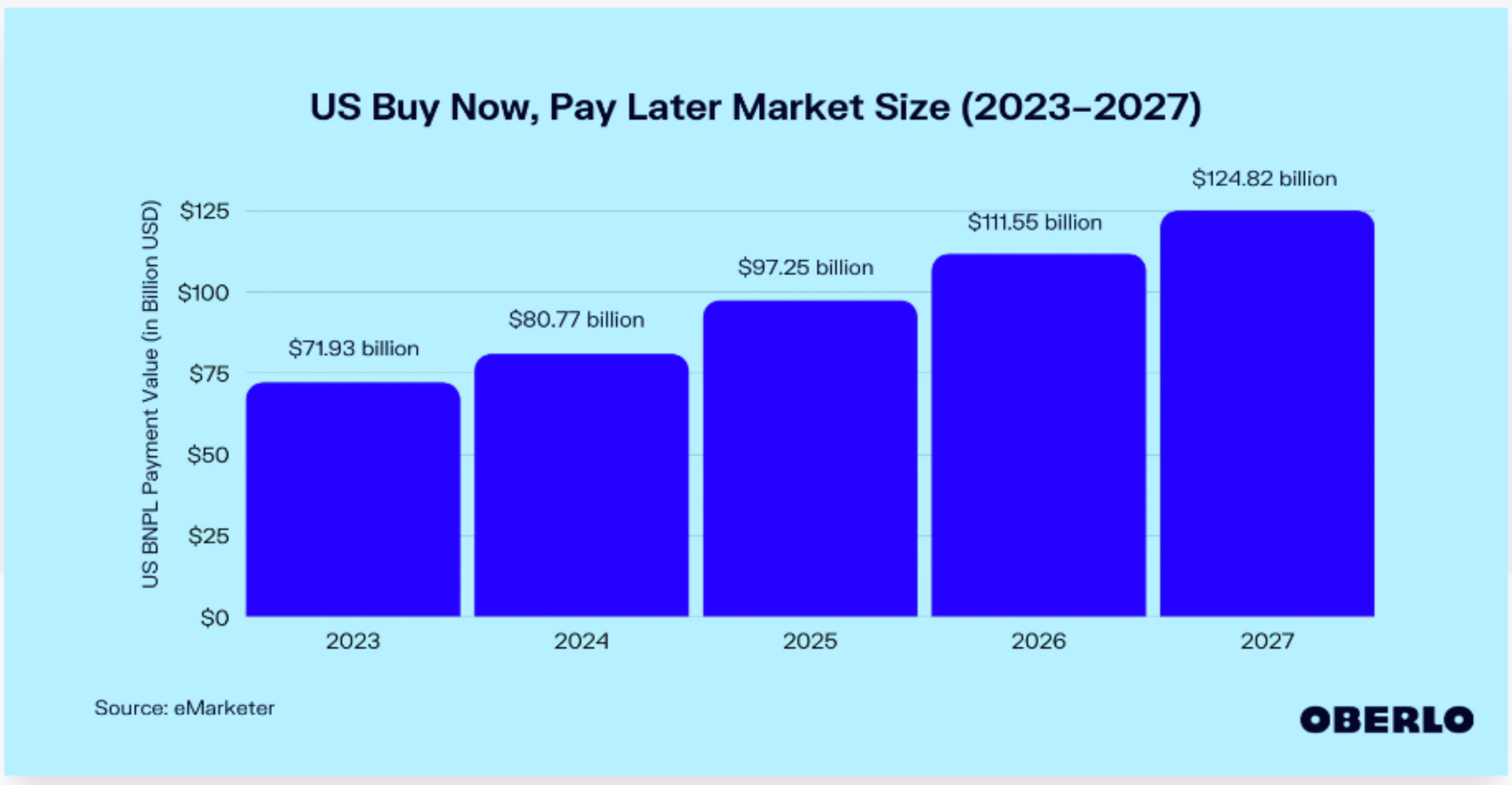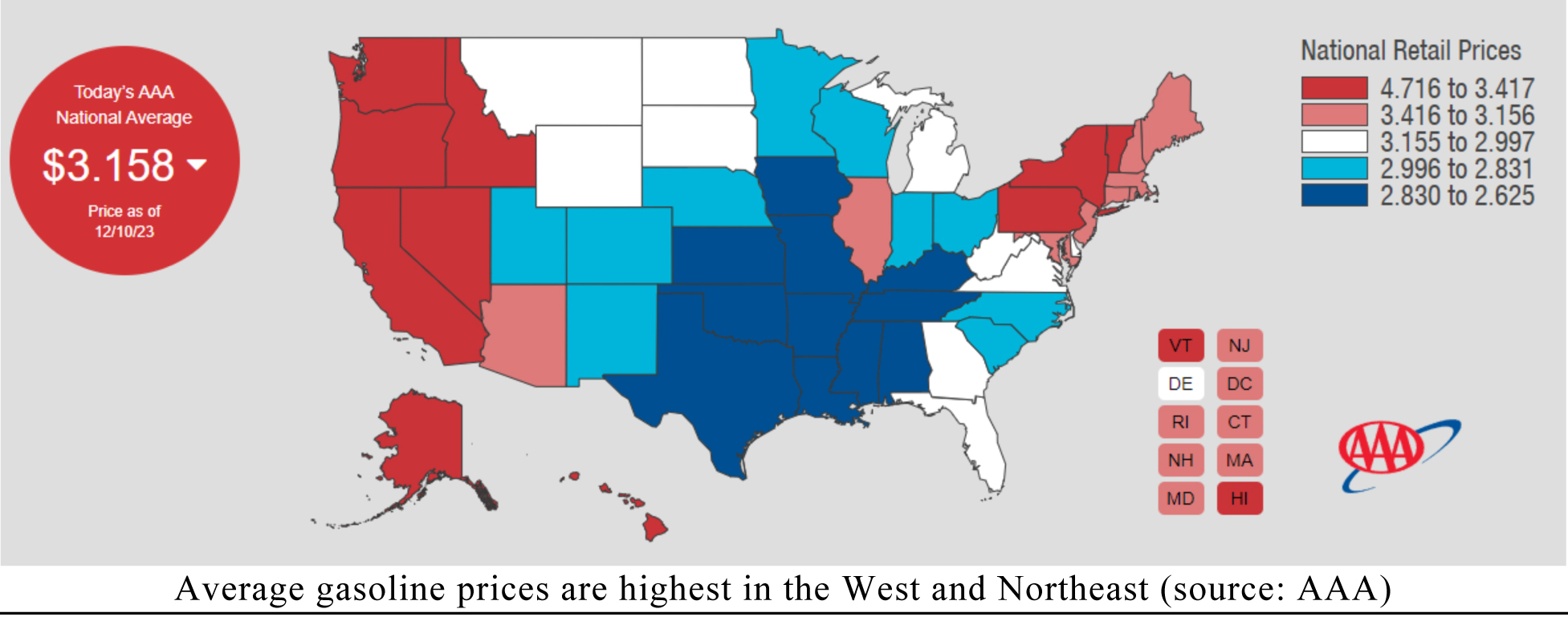by Bryan Perry
December 12, 2023
It is hard to find a seasoned investor that doesn’t believe the stock market is overbought on a short-term basis, but there are some underlying catalysts that continue to fuel investor enthusiasm. Here are a few:
Bond prices have literally “spiked,” sending mid-term to long-term yields decidedly lower, which has taken the average 30-year mortgage rate back down to the low 7% level and threatening to move into 6% territory. The 15-year mortgage rate could well get back into the 5% range as well. This week’s inflation data could help push rates lower. The CPI is due out today (Tuesday), with the PPI due out Wednesday.

Graphs are for illustrative and discussion purposes only. Please read important disclosures at the end of this commentary.
The latest employment data shows that labor markets continue to loosen as the economy added 199,000 non-farm payroll jobs in November, marking the second consecutive month with job additions below the average 240,000 (over the past year). Healthcare was the biggest contributor, adding 77,000 jobs, with local governments adding 49K. Manufacturing added 28K jobs, even as the UAW strikers returned 30k to their jobs during the month, and retail shed an eyebrow-raising 38K jobs heading into the holiday season.
On the negative side, there is a tale of two economies in the U.S., telling two starkly different stories. A recent Harris poll found that about 65% of working Americans say that they frequently live paycheck to paycheck, and 35% say they don’t have any money left at the end of most months. At the same time, we saw record sales on Black Friday ($9.12 billion) and Cyber Monday ($11.3 billion), with the caveat that Buy Now, Pay Later (BNPL) hit an all-time high, up 43% from a year ago, according to Adobe Analytics.
Also, CNN reported: “During the third quarter, the rate of households becoming delinquent or entering serious delinquency (90 days or more behind) on their credit cards, was the highest since the end of 2011, according to the Federal Reserve Bank of New York’s latest Quarterly Report on Household Debt and Credit released this month. Despite being fairly broad-based, with significant take-up among higher educated and higher income respondents… we find that those with lower credit scores and greater unmet credit needs make up a disproportionate share of all BNPL users.”

Graphs are for illustrative and discussion purposes only. Please read important disclosures at the end of this commentary.
So, there is potential of a stressed and leveraged consumer heading into the first quarter of 2024. The labor market will dictate consumer sentiment. We are already seeing hiring freezes in some industries, which are historically followed by layoffs – already announced among technology and financial companies. Will this layoff trend pick up speed in 2024? That is yet to be determined.
Wall Street doesn’t seem to be concerned about the consumer, but is buying into the rally that left many a damaged investor from the August-October correction bloodied, battered and cautious, as the yield on the 10-year Treasury note hit 5.0%, with JPMorgan CEO Jamie Dimon warning, “Are you prepared for something like 7%?” America’s biggest banking honcho carries a lot of weight when he raises the caution flag, but by mid-November, inflation data started to prove him wrong.
Additionally, and to the surprise of many, oil prices have slid hard as inventories have risen amid worries over weakness, both in end-demand and in concerns about the duration of OPEC+ supply cuts, the widespread cheating of quotas, and dumping of crude on black markets by Russia and Iran.
The national average price of gas has dropped to $3.15 per gallon, providing widespread relief to consumers and businesses alike – especially in the transportation sector. Cheaper gas prices were reflected in last week’s better-than-forecast University of Michigan Consumer Sentiment reading.

Graphs are for illustrative and discussion purposes only. Please read important disclosures at the end of this commentary.
Several analysts are blaming lower oil prices on a slowing Chinese economy, with large cracks in the commercial real estate market and the huge shadow banking industries. The year-to-date chart of the benchmark Shanghai Composite Index is showing signs of breaking down further, even after President Xi came to San Francisco to tell American companies that China is open for business.

Graphs are for illustrative and discussion purposes only. Please read important disclosures at the end of this commentary.
Add to this mix the impact AI is having on market sentiment and the halo effect it is having on dozens of stocks outside the Magnificent Seven. With the rally broadening out to include the regional bank and small cap sectors that are now in their second week of market gains, there is growing conviction that a retracement of the major averages before year-end may not materialize.
The Fed might try to maintain its “higher for longer” policy narrative, but the bond market isn’t having any part of it. Bond traders are on the side that “inflation is falling,’ to where the Fed can consider cutting rates as early as March, leading to an easing of financial conditions with the cost of capital coming down materially, that will afford the economy to avert a recession. Wall Street bulls are embracing this very dynamic – that the power of lower interest rates pretty much cures all that currently ails the bear case for a hard landing. So far, that has been the right call.
All content above represents the opinion of Bryan Perry of Navellier & Associates, Inc.
Also In This Issue
A Look Ahead by Louis Navellier
Global Conflicts Escalate in Some Energy Hot Spots
Income Mail by Bryan Perry
Investors Face a Mix of Year-End Bullish and Bearish Forces
Growth Mail by Gary Alexander
The Fed’s Latest Bumbling Invites King Midas to the Rescue
Global Mail by Ivan Martchev
There Could be A Simple Explanation for the Dax Moonshot Move
Sector Spotlight by Jason Bodner
From “Oversold” to “Overbought” in a New York Minute
View Full Archive
Read Past Issues Here

Bryan Perry
SENIOR DIRECTOR
Bryan Perry is a Senior Director with Navellier Private Client Group, advising and facilitating high net worth investors in the pursuit of their financial goals.
Bryan’s financial services career spanning the past three decades includes over 20 years of wealth management experience with Wall Street firms that include Bear Stearns, Lehman Brothers and Paine Webber, working with both retail and institutional clients. Bryan earned a B.A. in Political Science from Virginia Polytechnic Institute & State University and currently holds a Series 65 license. All content of “Income Mail” represents the opinion of Bryan Perry
Important Disclosures:
Although information in these reports has been obtained from and is based upon sources that Navellier believes to be reliable, Navellier does not guarantee its accuracy and it may be incomplete or condensed. All opinions and estimates constitute Navellier’s judgment as of the date the report was created and are subject to change without notice. These reports are for informational purposes only and are not a solicitation for the purchase or sale of a security. Any decision to purchase securities mentioned in these reports must take into account existing public information on such securities or any registered prospectus.To the extent permitted by law, neither Navellier & Associates, Inc., nor any of its affiliates, agents, or service providers assumes any liability or responsibility nor owes any duty of care for any consequences of any person acting or refraining to act in reliance on the information contained in this communication or for any decision based on it.
Past performance is no indication of future results. Investment in securities involves significant risk and has the potential for partial or complete loss of funds invested. It should not be assumed that any securities recommendations made by Navellier. in the future will be profitable or equal the performance of securities made in this report. Dividend payments are not guaranteed. The amount of a dividend payment, if any, can vary over time and issuers may reduce dividends paid on securities in the event of a recession or adverse event affecting a specific industry or issuer.
None of the stock information, data, and company information presented herein constitutes a recommendation by Navellier or a solicitation to buy or sell any securities. Any specific securities identified and described do not represent all of the securities purchased, sold, or recommended for advisory clients. The holdings identified do not represent all of the securities purchased, sold, or recommended for advisory clients and the reader should not assume that investments in the securities identified and discussed were or will be profitable.
Information presented is general information that does not take into account your individual circumstances, financial situation, or needs, nor does it present a personalized recommendation to you. Individual stocks presented may not be suitable for every investor. Investment in securities involves significant risk and has the potential for partial or complete loss of funds invested. Investment in fixed income securities has the potential for the investment return and principal value of an investment to fluctuate so that an investor’s holdings, when redeemed, may be worth less than their original cost.
One cannot invest directly in an index. Index is unmanaged and index performance does not reflect deduction of fees, expenses, or taxes. Presentation of Index data does not reflect a belief by Navellier that any stock index constitutes an investment alternative to any Navellier equity strategy or is necessarily comparable to such strategies. Among the most important differences between the Indices and Navellier strategies are that the Navellier equity strategies may (1) incur material management fees, (2) concentrate its investments in relatively few stocks, industries, or sectors, (3) have significantly greater trading activity and related costs, and (4) be significantly more or less volatile than the Indices.
ETF Risk: We may invest in exchange traded funds (“ETFs”) and some of our investment strategies are generally fully invested in ETFs. Like traditional mutual funds, ETFs charge asset-based fees, but they generally do not charge initial sales charges or redemption fees and investors typically pay only customary brokerage fees to buy and sell ETF shares. The fees and costs charged by ETFs held in client accounts will not be deducted from the compensation the client pays Navellier. ETF prices can fluctuate up or down, and a client account could lose money investing in an ETF if the prices of the securities owned by the ETF go down. ETFs are subject to additional risks:
- ETF shares may trade above or below their net asset value;
- An active trading market for an ETF’s shares may not develop or be maintained;
- The value of an ETF may be more volatile than the underlying portfolio of securities the ETF is designed to track;
- The cost of owning shares of the ETF may exceed those a client would incur by directly investing in the underlying securities; and
- Trading of an ETF’s shares may be halted if the listing exchange’s officials deem it appropriate, the shares are delisted from the exchange, or the activation of market-wide “circuit breakers” (which are tied to large decreases in stock prices) halts stock trading generally.
Grader Disclosures: Investment in equity strategies involves substantial risk and has the potential for partial or complete loss of funds invested. The sample portfolio and any accompanying charts are for informational purposes only and are not to be construed as a solicitation to buy or sell any financial instrument and should not be relied upon as the sole factor in an investment making decision. As a matter of normal and important disclosures to you, as a potential investor, please consider the following: The performance presented is not based on any actual securities trading, portfolio, or accounts, and the reported performance of the A, B, C, D, and F portfolios (collectively the “model portfolios”) should be considered mere “paper” or pro forma performance results based on Navellier’s research.
Investors evaluating any of Navellier & Associates, Inc.’s, (or its affiliates’) Investment Products must not use any information presented here, including the performance figures of the model portfolios, in their evaluation of any Navellier Investment Products. Navellier Investment Products include the firm’s mutual funds and managed accounts. The model portfolios, charts, and other information presented do not represent actual funded trades and are not actual funded portfolios. There are material differences between Navellier Investment Products’ portfolios and the model portfolios, research, and performance figures presented here. The model portfolios and the research results (1) may contain stocks or ETFs that are illiquid and difficult to trade; (2) may contain stock or ETF holdings materially different from actual funded Navellier Investment Product portfolios; (3) include the reinvestment of all dividends and other earnings, estimated trading costs, commissions, or management fees; and, (4) may not reflect prices obtained in an actual funded Navellier Investment Product portfolio. For these and other reasons, the reported performances of model portfolios do not reflect the performance results of Navellier’s actually funded and traded Investment Products. In most cases, Navellier’s Investment Products have materially lower performance results than the performances of the model portfolios presented.
This report contains statements that are, or may be considered to be, forward-looking statements. All statements that are not historical facts, including statements about our beliefs or expectations, are “forward-looking statements” within the meaning of The U.S. Private Securities Litigation Reform Act of 1995. These statements may be identified by such forward-looking terminology as “expect,” “estimate,” “plan,” “intend,” “believe,” “anticipate,” “may,” “will,” “should,” “could,” “continue,” “project,” or similar statements or variations of such terms. Our forward-looking statements are based on a series of expectations, assumptions, and projections, are not guarantees of future results or performance, and involve substantial risks and uncertainty as described in Form ADV Part 2A of our filing with the Securities and Exchange Commission (SEC), which is available at www.adviserinfo.sec.gov or by requesting a copy by emailing info@navellier.com. All of our forward-looking statements are as of the date of this report only. We can give no assurance that such expectations or forward-looking statements will prove to be correct. Actual results may differ materially. You are urged to carefully consider all such factors.
FEDERAL TAX ADVICE DISCLAIMER: As required by U.S. Treasury Regulations, you are informed that, to the extent this presentation includes any federal tax advice, the presentation is not written by Navellier to be used, and cannot be used, for the purpose of avoiding federal tax penalties. Navellier does not advise on any income tax requirements or issues. Use of any information presented by Navellier is for general information only and does not represent tax advice either express or implied. You are encouraged to seek professional tax advice for income tax questions and assistance.
IMPORTANT NEWSLETTER DISCLOSURE:The hypothetical performance results for investment newsletters that are authored or edited by Louis Navellier, including Louis Navellier’s Growth Investor, Louis Navellier’s Breakthrough Stocks, Louis Navellier’s Accelerated Profits, and Louis Navellier’s Platinum Club, are not based on any actual securities trading, portfolio, or accounts, and the newsletters’ reported hypothetical performances should be considered mere “paper” or proforma hypothetical performance results and are not actual performance of real world trades. Navellier & Associates, Inc. does not have any relation to or affiliation with the owner of these newsletters. There are material differences between Navellier Investment Products’ portfolios and the InvestorPlace Media, LLC newsletter portfolios authored by Louis Navellier. The InvestorPlace Media, LLC newsletters contain hypothetical performance that do not include transaction costs, advisory fees, or other fees a client might incur if actual investments and trades were being made by an investor. As a result, newsletter performance should not be used to evaluate Navellier Investment services which are separate and different from the newsletters. The owner of the newsletters is InvestorPlace Media, LLC and any questions concerning the newsletters, including any newsletter advertising or hypothetical Newsletter performance claims, (which are calculated solely by Investor Place Media and not Navellier) should be referred to InvestorPlace Media, LLC at (800) 718-8289.
Please note that Navellier & Associates and the Navellier Private Client Group are managed completely independent of the newsletters owned and published by InvestorPlace Media, LLC and written and edited by Louis Navellier, and investment performance of the newsletters should in no way be considered indicative of potential future investment performance for any Navellier & Associates separately managed account portfolio. Potential investors should consult with their financial advisor before investing in any Navellier Investment Product.
Navellier claims compliance with Global Investment Performance Standards (GIPS). To receive a complete list and descriptions of Navellier’s composites and/or a presentation that adheres to the GIPS standards, please contact Navellier or click here. It should not be assumed that any securities recommendations made by Navellier & Associates, Inc. in the future will be profitable or equal the performance of securities made in this report.
FactSet Disclosure: Navellier does not independently calculate the statistical information included in the attached report. The calculation and the information are provided by FactSet, a company not related to Navellier. Although information contained in the report has been obtained from FactSet and is based on sources Navellier believes to be reliable, Navellier does not guarantee its accuracy, and it may be incomplete or condensed. The report and the related FactSet sourced information are provided on an “as is” basis. The user assumes the entire risk of any use made of this information. Investors should consider the report as only a single factor in making their investment decision. The report is for informational purposes only and is not intended as an offer or solicitation for the purchase or sale of a security. FactSet sourced information is the exclusive property of FactSet. Without prior written permission of FactSet, this information may not be reproduced, disseminated or used to create any financial products. All indices are unmanaged and performance of the indices include reinvestment of dividends and interest income, unless otherwise noted, are not illustrative of any particular investment and an investment cannot be made in any index. Past performance is no guarantee of future results.
